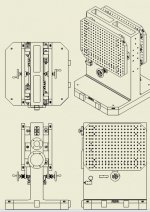Just one part on each side. The bores are anywhere from 2.5 in to 12 in. I want the universal grid to accommodate all sorts of parts that we may encounter. One thing that may not be evident is this is a giant tombstone, 1000mm x 1000mm pallet, the grid plates shown are 2" thick, 1000mm x 750mm.
We have a fixture similar to my concept and it works OK but takes an excessive amount of time to dial in, it uses barrel hinge at bottom a cam type adjuster at top with pull springs to hold the plate against the cams. Also it uses flexural steel hydraulic brakes that hug the tombstone sides from both sides at the top whereas my brakes are on the same side and the hinge allows lateral movement meaning as hydraulic pressure is released the fixture would slide to the right and then under when clamping, slide to the left until the braking blocks mated. The reason I put the hinge in the middle is so I could use die springs at the top to always put pressure on the differential screw, although in practice the weight alone would probably be sufficient.
In process my probe program would measure the appropriate plane and then direct the operator to turn the differential screw so many turns, in this design one rotation equals 2 thousandths, I might put a waterproof indicator on there to make things easier.
I am taking the feedback and now working on what you specifically not recommending, tilting the tombstone. My current concept use a living hinge, a wedge block for height adjustment, a plurality of hydraulic work supports under the tombstone and then 4 big hollow cylinders at each corner. Still playing around with this idea.
View attachment 319489






